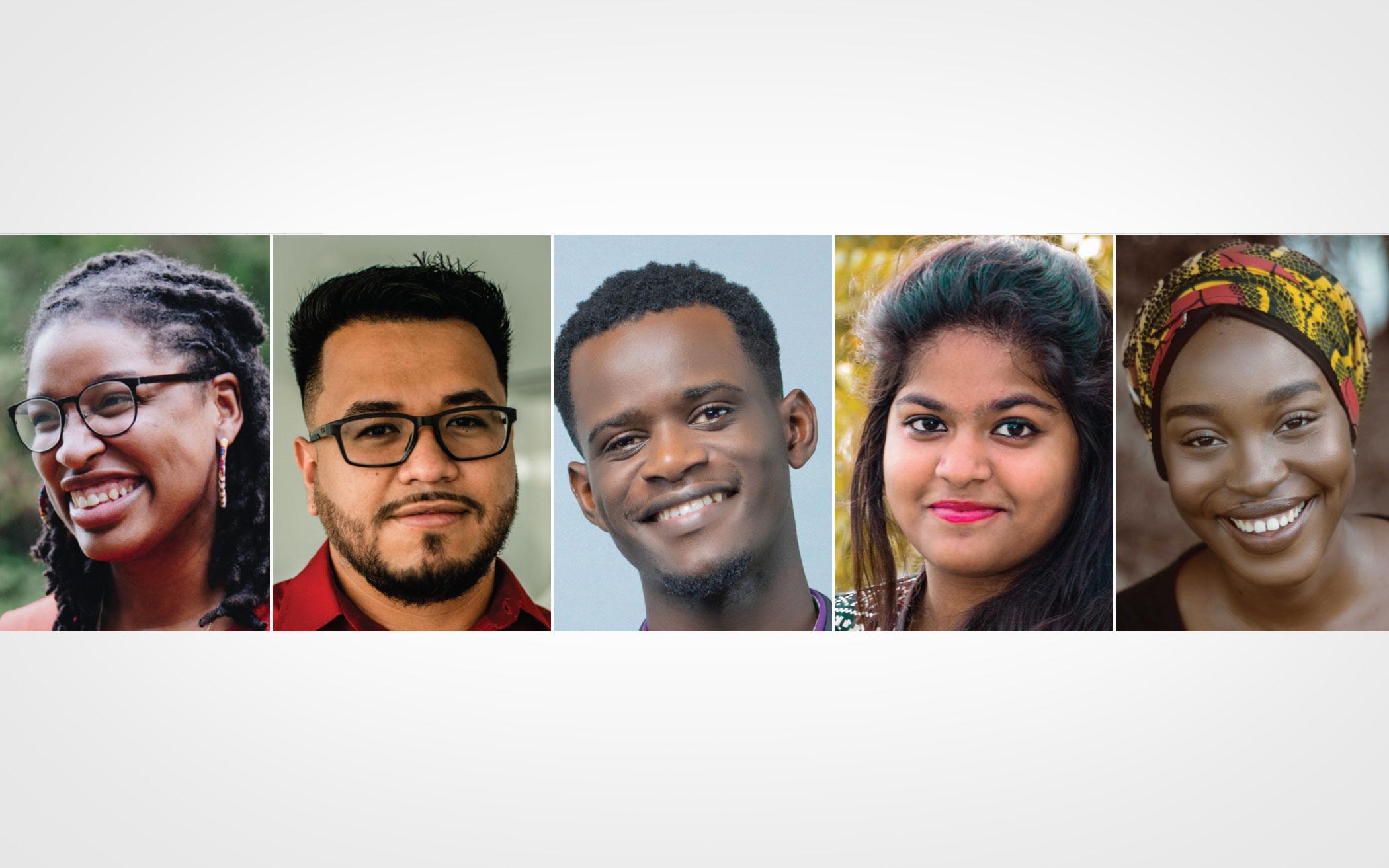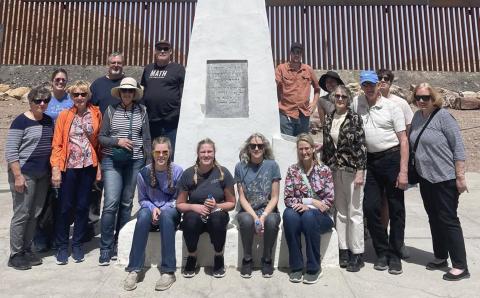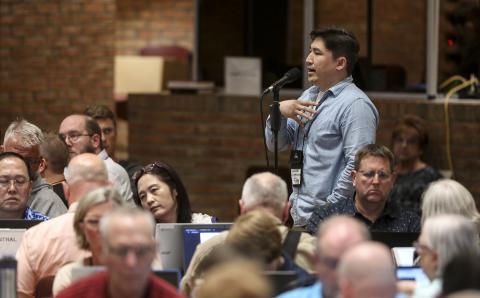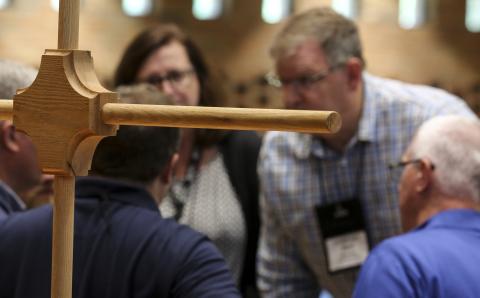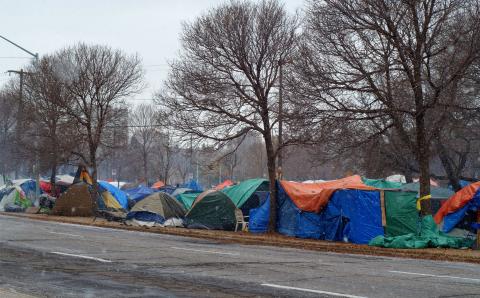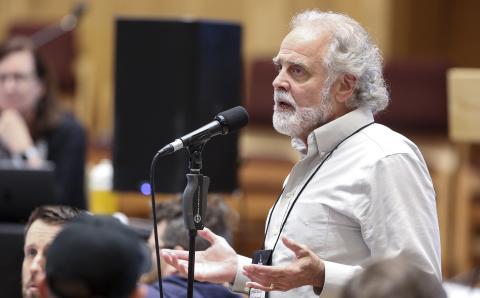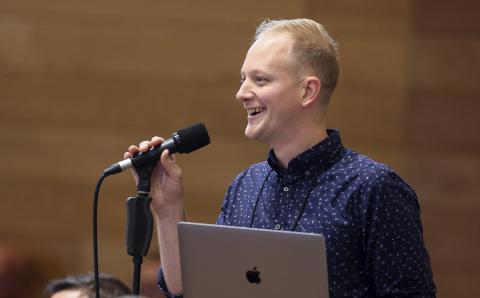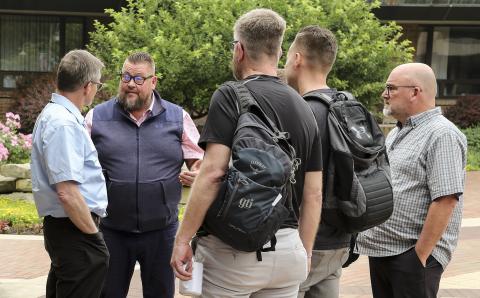Because of an intense interest in the Reformed tradition in recent years, the Christian Reformed Church in America has become substantially more diverse. While elements of diversity have been there all along, there is great cause for celebration as people from Korea, Central and South America, Africa, the Middle East, and Southeast Asia have either formed their own congregations or joined existing churches.
Clearly, the face of the once-primarily Dutch denomination is in transition. But becoming more diverse has not been easy. The journeys of some churches reflect the challenges and uncertain twists in the road leading to the grand kingdom vision described in Revelation 9:7: “After this I looked, and there before me was a great multitude that no one could count, from every nation, tribe, people and language standing before the throne and before the Lamb.”
Willowdale CRC, Toronto, Ont.
After immigrating in 2007 from Iran to Toronto, Ont., Sylvie Charliekaram and her husband, Nasser Zand, began looking for a church.
“We wanted a church where we could feel the love and protection of God,” Charliekaram said. “We wanted a church familiar with the Reformed tradition and doctrine. We looked and searched and prayed. We came across Willowdale CRC, and they welcomed us. It was as simple as that.”
At the time, Willowdale was struggling. Members were mostly Dutch and older. Its future was uncertain. But opening its heart and its doors to people from a different cultural background has become a sustaining gift for Willowdale.
“We want to be a church for all nations and have been willing to go through the challenges and sacrifices to make that happen,” said Lesli van Milligen, a member of Willowdale’s preaching team and co-director of the CRC’s Congregational Ministries.
Today, almost half of Willowdale’s congregation speaks Farsi, the main language of Iran. Charliekaram and Zand continue to serve as congregational leaders. More than 100 baptisms have taken place, mostly of children of immigrant parents, and the Sunday worship service uses a mix of English and Farsi.
Charliekaram’s background as a Christian who married a Muslim man has played a key role as Sylvie has helped navigate the challenges and disappointments of building diversity at Willowdale. She is acutely aware of how the intricacies of faith can weave in complex ways through a person’s life.
“New people and even long-time members need a lot of time and patience to be discipled into a new way of living and being together,” she said. “We need to realize that everyone has a culture with its own elements, and we need to honor that as we work with the people.”
A 30,00-foot View
Churches across the CRC have learned that creating a multicultural congregation can be difficult, and many churches have yet to start the process.
“Becoming more diverse has been a challenge for years,” said Reggie Smith, the CRC’s director of diversity. “So many CRC churches haven’t had it in their DNA to do outreach. Instead they really need to be pushing the boundaries, often leaving an old culture and accepting a new culture.”
“The key for a church to grow in diversity is for traditional churches to take the stance that they need to reach out and be welcoming to others,” said Bing Goei, former director of Race Relations for the CRC (an agency that is now part of a group of congregational ministries to be called "Thrive") and a member of East Leonard CRC in Grand Rapids, Mich. “To be diverse, churches need to find ways to adapt to others while at the same time sharing the gospel. Often it is not a matter of them becoming like me, but of me becoming like them.”
New Westminster CRC, Burnaby, B.C.
Although New Westminster CRC still had a solid footing, a few years ago pastor Andrew Beunk was looking hard at the future of his largely white church with Dutch ancestry. He realized, with the help of then-associate pastor and missiologist Michael Goheen, that in order to thrive in the future New Westminster needed to open itself to the wider world and especially the changing neighborhood around the church.
This isn’t to say that the church, founded in the early 1950s, had neglected responding to the needs of others, Beunk said.
“Early on, because education was so important to the members, the church built a Christian school,” he said. Outreach and refugee resettlement were also crucial. “In the (19)70s and ’80s,” Beunk added, “we took in refugees from Cambodia and elsewhere. We have also sponsored refugees from Afghanistan and Syria and continue to do that.”
And New Westminster has always prioritized outreach. “The Holy Spirit has always opened us to diverse cultures in meaningful ways,” Beunk said. A few years ago, the church transformed its parsonage into a center for international students from local colleges and hired Hyung Jun Kim, a Korean pastor who initially worked with the international students and eventually became New Westminster’s pastor of multicultural leadership and discipleship, reaching out to the growing Korean population in the neighborhood around the church. In essence, Kim is helping to realize the vision Beunk and Goheen had of finding a way to engage and attract new church members from their neighborhood.
“I was serving as a pastor at a Korean Presbyterian church in the area before coming here,” Kim said. “I left that church because I wanted experience and to broaden my understanding of church outside the bubble I was in.”
At first, he attended New Westminster “to get a deeper understanding of the wider Canadian church” and especially of how a Reformed congregation lived out its faith. After he was hired, he said, “I slowly leaned into my job and began connecting with people who started to learn that New Westminster had room for them. Korean families saw that at this church they could build a life together with others.”
Today, more than 40% of church members are Korean or come from ethnic groups other than the historically Dutch majority, Beunk said. The next challenge, Beunk said, will be to foster deeper relationships and friendships between those long-time members and those who are part of a more recent wave of immigrants to the area. “We have been preaching about the need to sit down at the table (outside of Sunday worship) and letting the Holy Spirit help us to go deeper and to bring people together,” he said.
Resurrection Church, East Boston, Mass.
Another road to diversity in the CRC has come through church plants, such as Resurrection Church in East Boston, Mass. Before launching Resurrection about four years ago, Justin and Sarah Ruddy and a few others took an in-depth look at the history and demographics of the neighborhood and the range of resources available to its mostly Latino population.
“We had a core group of people that prayed for God to work in us and to reach beyond ourselves into the community,” Justin Ruddy said. “It has been a self-emptying process that had to happen, and that is hard. We realized we needed to do ministry for those who are below the poverty line as well as those who are more well-to-do. If we want to do multicultural ministry, it has to go all the way down. It can’t just be a good idea you are trying out.”
Raul Hernandez and his family are members of the church. They were attracted to the Reformed view of faith as part of everyday life—a view Hernandez had appreciated at his evangelical church in Honduras. After the family emigrated to Texas, Hernandez learned about the CRC and Reformed doctrine from a pastor friend, and when the Hernandezes moved to East Boston, they found Resurrection.
“We looked online, and God put in our path Resurrection Church, which represented an obstacle owing to that we only speak Spanish, but there was something inside our hearts that brought us to them, and (the language problem) did not matter to us,” Hernandez said in an email translated from Spanish.
After starting to attend Resurrection, he said, “we felt really good because of the reception that all the members of the church gave us. In Resurrection we have found things that we have never experienced in our former churches—things that I consider a gift for our family and for our community in general. You can see and feel the presence of God, from the services and the preaching to the social gatherings. In all areas of the church, the person of Jesus Christ is praised and exalted.”
African Community Fellowship, Kentwood, Mich.
Sitting in his church office, John Mondi spoke of the challenges he’s faced as pastor of African Community Fellowship CRC, a congregation in Kentwood, Mich., that is home to scores of immigrants and refugees from countries across Africa.
“Other than a few services here or at other churches in the CRC, we haven't blended very much with our Dutch brothers and sisters,” said Mondi, who grew up in Kenya.
On Sundays, people from countries such as Sudan, Tanzania, Ethiopia, Uganda, and Nigeria gather at Mondi’s church to sing songs from those countries and hear prayers and a sermon in English.
Some of the church members are refugees who fled war and starvation; others are students; others came to the U.S. to live and work. Some have lived here for many years.
One of Mondi’s particular challenges is that many of his newer church members work at low-paying jobs and, after paying their bills, have little left over to give to the church. Although more than 150 people call this church home, Mondi is the only person on the payroll.
“We have seen good growth, but we cannot hire anyone to help out,” said Mondi, who is also a member of Resonate Global Mission’s West Michigan missions team. “We could grow more, especially in the area of youth ministry, but to sustain that ministry we need more resources.”
Despite its financial struggles, the church was able to raise enough money to expand its building to accommodate the growing membership.
“We are grateful to be where we are and appreciate being in the CRC,” Mondi said. “We continue to pray that God and others will walk alongside us as we go forward.”
Four Corners CRC, Teec Nos Pos, Ariz.
Members of the Navajo Nation have been part of the CRC for more than a century. But about 20 years ago, CRC pastors and mission workers began to leave the area. Many pulpits were left without preachers, threatening the very existence of this unique part of the denomination.
Hoping to preserve the Navajo CRCs was Classis Red Mesa’s Leadership Development Network. The LDN formed in 2008 to train church leaders along the border of Arizona and New Mexico.
Among LDN’s first students were James and Darleen Litson from Four Corners CRC in northeast Arizona.
“There were eight of us in the first bunch. We were the guinea pigs,” said Darleen Litson, who grew up at Four Corners. “Over three years, they taught us preaching and the Bible and other things in two classes a month.”
Getting LDN up and running “was a ton of work and a lot of blood, sweat, and tears,” said Ruth Benally, one of LDN’s early teachers, “but by God’s grace we got it off the ground.”
“People really needed something like this. We offered training that wasn’t available before,” said Lora Copley, another early LDN leader. “We asked students to dig into Scripture and see how it applies to boots on the ground. … We asked them to devise ministry plans and make them happen in their communities.”
Darleen Litson said she and her husband found ways to shore up ministry at Four Corners through their ministry plans. Then, after they graduated from LDN and were licensed to preach, James Litson began preaching at the church.
LDN has certainly played a role in preserving Native American churches and their diversity across the rugged desert country and mountainous landscape in New Mexico, Arizona, and part of Utah. But, like many churches today, those congregations are seeing young people leave to worship elsewhere or not at all. “The LDN has given us leaders,” Darleen Litson said, “but we are getting old and need to step aside for younger people to do it.”
Yet she believes there is hope—a grand and glorious hope—because the CRC, despite its shortcomings, has fostered a sense of God’s presence in Red Mesa over the decades.
Despite all the challenges Red Mesa churches have faced, God has not failed them in over a century, said Litson and others, and the Lord will build and preserve diversity in God’s church many years to come.
About the Author
Chris Meehan is a freelance writer and commissioned pastor at Coit Community Church in Grand Rapids, Mich.

